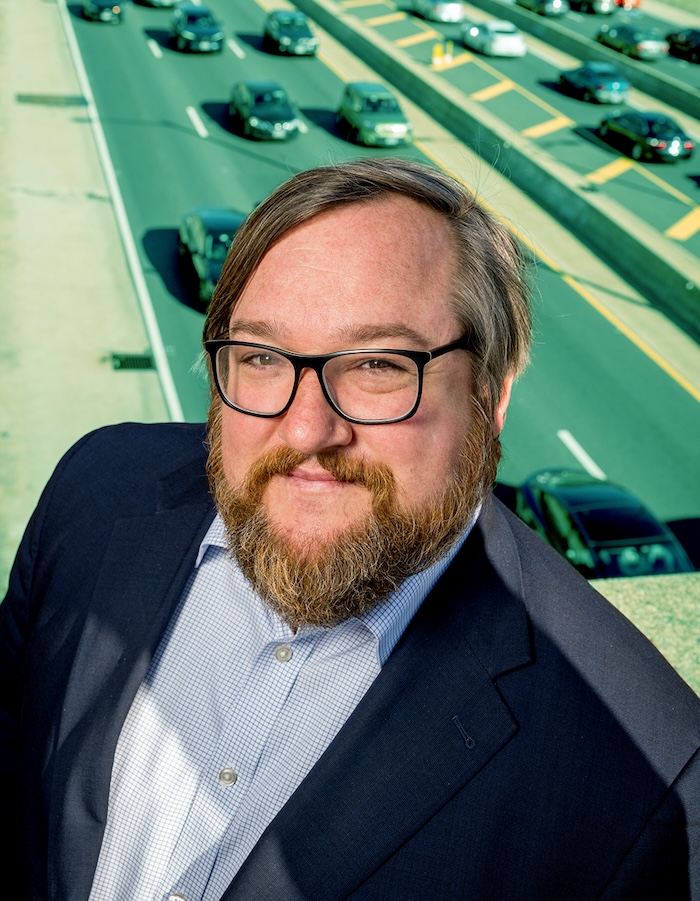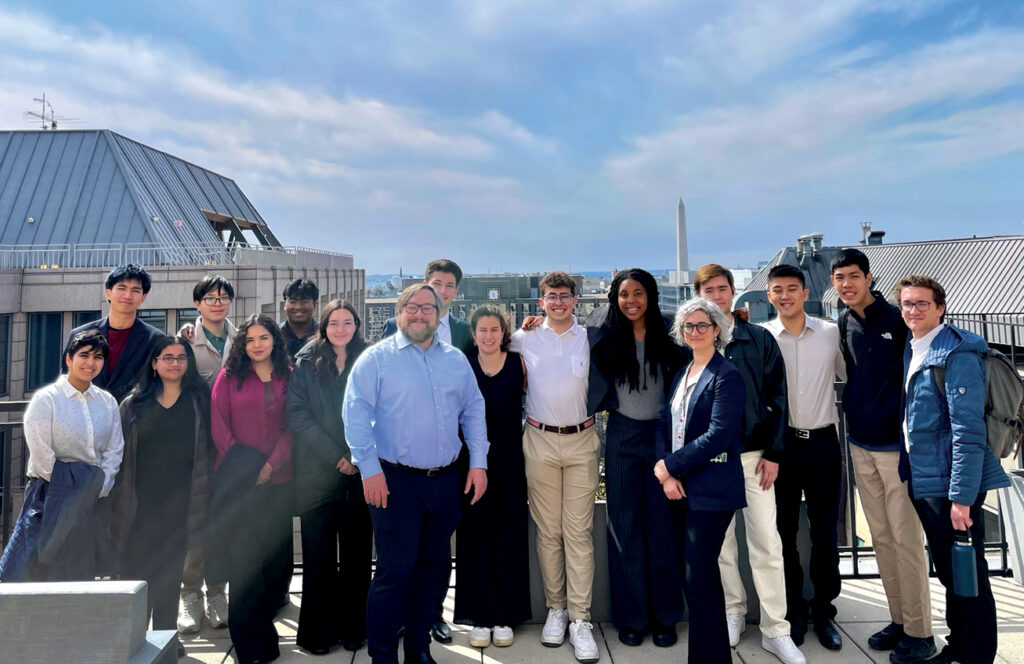

Austin Brown ’02, a technology and policy expert passionate about developing better, more efficient transportation systems, serves as the director of the Vehicle Technologies Office (VTO) at the U.S. Department of Energy. Brown leads critical research, development and deployment efforts aimed at accelerating the transition to a prosperous and sustainable transportation future.
“The transportation sector is essential to our quality of life and the economy, but it also contributes to some of our biggest problems,” says Brown. “Our mission is to fund impactful research that creates innovation, improves choices, makes transportation safer, cheaper and more accessible, and eliminates pollution while we’re at it.”
The VTO invests about $450 million a year, making it the largest public funder worldwide of applied research and development for clean mobility. Its initiatives encompass advancing battery and electric vehicle (EV) technology for cars and trucks, improving heavy-duty engines, building resilient domestic supply chains and exploring innovative solutions like vehicle-to-grid integration and automated transportation. Collaborating with other government agencies, private industry and academic institutions, the VTO funds projects that improve system efficiency while addressing societal challenges such as safety and affordability.
A Vision for Transportation
Brown’s journey toward applied solutions began during his undergraduate years as a physics student at Harvey Mudd, though he didn’t know it at the time as he focused on astrophysics. During grad school in biophysics, he found that his love of discovery was transformed into a desire to use knowledge for real-world impact. After earning a PhD from Stanford University, Brown served in Washington, D.C., first as an American Association for the Advancement of Science Fellow at the Department of Energy, at the National Renewable Energy Laboratory and as assistant director for clean energy and transportation at the White House Office of Science and Technology Policy. For four years, he was executive director of the Policy Institute for Energy, Environment and the Economy at the University of California, Davis, and, most recently, he was senior director for Transportation Emissions at the White House Climate Policy Office. As head of the VTO since August 2023, Brown seeks to create solutions that benefit people and the planet.
“How do we move our people and our stuff and get access to the things that transportation gets us, like opportunity and family and education, but eliminate the emissions so that it’s not causing harm?” Brown asks. “Every project we fund and every technology we pursue is designed to make transportation work better for everyone while addressing its impacts.”
Tackling the Challenges of Electrification
Electric vehicles (EVs) are a part of the VTO’s strategy, and Brown notes both their advantages and challenges. With over a million EVs sold in the U.S. in 2024 (representing about 10% of new vehicle sales), the technology is rapidly advancing. EVs are cheaper to maintain, quieter, and offer better performance compared to internal combustion engine vehicles. However, access to easy nationwide charging and mineral sourcing remain critical hurdles to address with research and deployment.

The VTO is driving innovation to lower battery costs—aiming for $75 per kilowatt-hour by 2030 (down from more than $1,000 in 2010 and around $120 today)—and exploring battery recycling and alternatives like sodium-based batteries to add technology diversity and ensure secure supply chains. Recent VTO funding initiatives include $43 million for improving EV battery safety and $72 million for developing charging infrastructure for medium- and heavy-duty vehicles.
In addition to advances in EV technology and infrastructure, the new interest in electric mobility is transforming personal transportation in myriad ways. In addition to cars, an area of growth in this space is one that Brown enjoys with his wife and 5-year-old son: electric bikes. U.S. sales of e-bikes exceeded $1 million in 2022. “I love how our family e-bikes get us around with exactly as much workout as we want, and I hear from folks all the time who find them to be a great part of their personal transportation toolkit.”
Addressing Pollution Burden
Increasing fairness and improving health is central to Brown’s work. “Local pollution from transportation disproportionately impacts communities that have the burdens of our system put upon them and receive fewer of the benefits. Transportation—the second biggest expense for households—is a big deal. If you can cut or eliminate their gasoline bill, that’s got ethical advantages as well,” he says.
By investing in clean technologies and locally driven programs, the VTO seeks to ensure that every community has a voice and receives benefits from the clean energy transition. “We have an ethical requirement to develop safer systems, eliminate transportation barriers and reduce pollution for disadvantaged communities.”
“We have an ethical requirement to develop safer systems, eliminate transportation barriers and reduce pollution for disadvantaged communities.”
Austin Brown ’02
Preparing for the Future: Automation and Beyond
Vehicle automation represents both an opportunity and a challenge for Brown and his 40-member team. While automated vehicles have the potential to reduce traffic fatalities and improve convenience, their environmental impact is uncertain. Automation could lead to increased energy use if it encourages more traffic. “We need to ensure automation aligns with our shared goals rather than exacerbating existing problems,” Brown says.
“Every realistic solution in energy has its downsides and issues,” he says. “One solution to a problem often creates some other problem as well. It’s a constant effort to think ahead to the unintended consequences.”
New Generation of Transportation Leaders
The VTO is preparing for what’s next by fostering the inventiveness of the next generation. One of Brown’s favorite projects, the EcoCAR EV Challenge, builds upon a 35-year history of the U.S. Department of Energy’s Advanced Vehicle Technology Competitions, which include more than 30,000 students as alumni. The four-year collegiate automotive engineering competition provides a hands-on educational experience to students at 15 North American universities—two in California (UC Riverside and UC Davis). Teams are in their third year engineering a next-generation battery electric vehicle—a GM Cadillac LYRIQ—that utilizes automation and vehicle-to-everything connectivity to implement energy-efficient and customer-pleasing features while meeting the decarbonization need of the automotive industry.
In an October 2024 interview with Great Day Live Tampa Bay, Brown said, “There are dozens of companies demonstrating automation and connectivity features, but they’re all doing it in their own research ecosystem and very fiercely protecting what they find. One of the benefits we’ll get from this competition is that we’re taking 13 approaches to connectivity, automation and propulsion systems, and pitting them against each other in a friendly competition where we’re able to compare apples to apples.
“Teams will be showcasing what [their cars] can do on a real road and in laboratory environments, where you can precisely measure energy use. We believe that this can help us showcase what are some of the standard tests that we should be able to use for the broader transportation innovation ecosystem to understand the implications of these different technologies in terms of their energy use reductions.”
Brown is also personally passionate about teaching anyone interested about how they can help build a better transportation system. Since 2012, he has taught at Johns Hopkins University, and since 2023 he has taught the elective Transportation Technology and Climate Policy as part of HMC’s Hixon Center for Climate and the Environment.
A Team Effort
Brown believes that the greatest impact is achieved by working together. He points out that his office’s investments need to catalyze billions in follow-on investments from industry to help improve the trillion-dollar-scale transportation system, so leverage is essential. From funding cutting-edge projects to engaging with communities, collaboration is key to navigating the complexities of clean mobility because the real decisions are all made by individuals, companies, local governments and states. Brown and his team at the Vehicle Technologies Office are laying the foundation for a sustainable transportation future—one that balances innovation, equity and environmental stewardship.